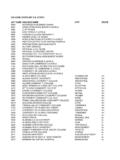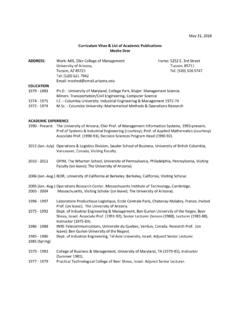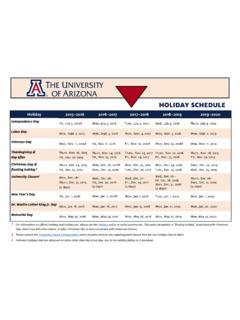Transcription of THE UNIVERSITY OF ARIZONA
1 THE UNIVERSITY OF ARIZONA Mount Graham International Observatory Emergency Response Contingency Plan Revision 10: 7/24/2012 Updated 2/6/2013 Prepared By: The UNIVERSITY of ARIZONA Steward Observatory Tucson, ARIZONA 85721 (520) 621-6524 Key Item Contents: Emergency Coordinators .. Appendix A Medical Emergency Procedures .. Appendix B Evacuation Procedures .. Appendix C Fire Response Plan .. Appendix D Hazardous Materials/Spill Response Plan .. Appendix E Emergency Response Information Center .. Appendix F Material Safety Data Sheets .. Appendix G i Mount Graham International Observatory Emergency Response Contingency Plan Table of Contents Table of Contents .. i Table of ii Appendices .. iii I. General Information .. 1 II. Emergency Coordinator Information .. 2 III. Events Leading to Implementation of the Contingency Plan .. 3 A. Fire and/or Explosion B.
2 Spills or Material Release C. Medical Emergency IV. Emergency Response Procedures .. 4 A. Initial Assessment and Notification .. 4 B. Identification of Hazardous Materials .. 5 C. Hazard Assessment .. 6 D. Control 7 E. Prevention Measures .. 7 F. Storage and Disposal of Released Material .. 8 G. Post-Emergency Equipment Maintenance .. 8 H. Emergency Equipment Availability and Location .. 8 I. Required Reports .. 8 V. Emergency Response Team Training .. 9 A. Regulatory Overview .. 9 B. Chemical Hazards ..10 C. Operating Procedures ..10 D. Hazard Communication Program ..10 E. Training for Emergency Response ..10 ii Mt. Graham International Observatory Emergency Response Contingency Plan Table of Exhibits 1. Chemical Requirements for the Mt. Graham International Observatory 2. Fuel and Lubricant Requirements for the Mt. Graham International Observatory 3.
3 Emergency Coordinator Authorization 4. Radio Communications 5. Local Authorities and Contractor Personnel (Telephone Contact List) 6. State and National Authorities (Telephone Contact List) 7. MGIO Emergency Equipment Assignments 8. Equipment Lockers Location and Inventories 9. Swift Trail-Road Reference Markers 10. Map of Southeastern ARIZONA 11. Map of Pinale o Mountains (Swift Trail) 12. MGIO Location/Site Plan 13. Map of Research Area and Access Road 14. Map of MGIO Site 15. Map of MGIO Site Utilities Area. 16. Schematic Diagram - Electrical Power Generation and Distribution System 17. Schematic Diagram - Propane Storage and Distribution System. 18. Schematic Diagram - Potable Water Storage and Distribution System. 19. Schematic Diagram - Diesel Fuel Transfer System iii Mount Graham International Observatory Emergency Response Contingency Plan Appendices A. Emergency Coordinators B.
4 Medical Emergency Procedures C. Evacuation Procedures 1. Situation 2. Assumptions 3. Mission 4. Concept of Operation D. Fire Response Plan 1. Notification Procedures 2. Purpose 3. Scope 4. Situation 5. Concept of Operation 6. Task Assignments E. Hazardous Materials/Spill Response Plan 1. Notification Procedures 2. Purpose 3. Scope 4. Situation 5. Concept of Operation F. Emergency Response Information Center G. Material Safety Data Sheets 1 Mount Graham International Observatory Emergency Response Contingency Plan The information contained herein is submitted in accordance with the requirements for a Chemical Waste Management Plan, Spill Control and Countermeasures Plan (SPCC Plan), and a Fire Response Plan, as contained in the Forest Service Special Use Permit and Management Plan for the Mt. Graham International Observatory. These plans are set forth in this document, called the Emergency Response Contingency Plan, also referred to as the Contingency Plan.
5 A copy of the Contingency Plan is available at the UNIVERSITY of ARIZONA Police Department (UAPD) and at the Risk Management Services (RMS) department along with strict operating and safety directives. Copies of this plan have also been provided to the Forest Service, Graham County Sheriff's Office, Southwest Ambulance, and the Department of Public Safety Air Rescue Branch, Tucson. I. General Information This Contingency Plan is for The UNIVERSITY of ARIZONA 's Mt. Graham International Observatory (MGIO), located on an acre area near Emerald Peak a 10,500' summit in the Pinale o Mountains, a part of the Coronado National Forest, near Safford, ARIZONA . The facility consists of three main buildings, a utility area and an access road: Submillimeter Telescope (SMT) Vatican Advanced Technology Telescope (VATT) Large Binocular Telescope Project (LBT) Utilities Building In addition to the mountain facilities, a Base Camp is located outside of the forest boundary immediately north of the Federal Correctional Institution on ARIZONA Highway 366 (also known as Swift Trail milepost ).
6 The UNIVERSITY is a land-grant educational institution controlled by the ARIZONA Board of Regents for the State of ARIZONA . Maps indicating the location of the MGIO in the context of Southeastern ARIZONA ; the Pinale o Mountains; the area surrounding the Observatory; and the Observatory site are contained in Exhibit 10 through Exhibit 15. Schematic diagrams of the on-site utilities are contained in Exhibits 16 (Electrical Power), Exhibit 17 (Propane System), and Exhibit 18 (Water Distribution). A milepost listing along State Highway 366 which ascends the Pinale o Mountains terminating at Riggs Flat Recreation Area is contained in Exhibit 9. The primary purpose of the Observatory facility is to provide a remote site in which to conduct astrophysical research. Operations and maintenance of the facility will require the use of small 2 I. General Information (continued) quantities of specific chemicals (identified in Exhibit 1) and the transport and handling of petroleum products such as propane, gasoline and diesel fuel (identified in Exhibit 2).
7 The chemicals will be used to clean electronic parts, printed circuit boards, etc. Also the majority of the acid/base chemicals will be used to clean and strip aluminum from telescope mirrors prior to re-aluminizing them. This process of on-site mirror aluminization generates wastewater with metals in solution. This wastewater is not classified as a hazardous waste. The chemical analysis of the wastewater is identified in Exhibit 1. In addition, disposal procedures are outlined for small quantities of waste oil from maintenance operations involving internal combustion engines. II. Emergency Coordinators If an emergency situation develops involving chemicals or fuels at the MGIO, the discoverer ( UNIVERSITY personnel, observers or observatory staff) will immediately contact an Emergency Coordinator listed in Appendix A. The primary Emergency Coordinator is to be contacted first and, if not available, a secondary Emergency Coordinator will be called (in the order listed) until someone is contacted.
8 The first of these individuals contacted becomes the Emergency Coordinator. The Emergency Coordinator can be contacted on a 24-hour basis through the UAPD Main Campus dispatch center. There will always be at least one Emergency Coordinator that can be contacted by pager or cell phone. The UAPD dispatchers have the phone/pager numbers of all the designated primary and secondary Emergency Coordinators. The decision to implement the Contingency Plan depends upon whether or not an imminent or actual incident could threaten human health or the environment. It is the duty of the Emergency Coordinator to determine if the Contingency Plan is to be implemented and to direct and coordinate all activities undertaken if the Plan is implemented. As indicated in Exhibit 3, the Emergency Coordinator is authorized to commit the resources of The UNIVERSITY of ARIZONA , as needed, to implement the Contingency Plan. The specific types of incidents that require implementation of the Contingency Plan are listed on page 3.
9 The Emergency Coordinators designated in Appendix A are UNIVERSITY of ARIZONA personnel who are directly involved in the training and/or management and handling of chemicals and fuels, and are trained in appropriate response measures. They can be contacted directly at the phone numbers listed with their names or through the UAPD. At least one of the Emergency Coordinators is always available by pager or cell phone 24 hours a day. 3 III. Events Leading to Implementation of the Contingency Plan The Contingency Plan will be implemented in any of the following situations: A. Fire and/or Explosion 1. A fire causes, or could cause, the release of significant amounts of toxic fumes. 2. The fire spreads and could possibly ignite nearby fuel storage. 3. The fire could possibly spread to off-site areas. 4. The fire cannot be contained immediately by the use of a fire extinguisher. 5. An explosion has occurred. B.
10 Spills or Material Release 1. The product that has been spilled has a Threshold Limit Value recommended by the American Conference of Governmental Industrial Hygienists of less than 10 parts per million or a reportable quantity has been reached. Reportable quantities are listed in Exhibit 1. 2. The spilled product is a hazardous material or petroleum product with the potential for ground water or surface water contamination, or is in a drainage where it could be carried off-site via surface run-off. 3. The spilled product cannot be contained on-site, resulting in a potential for off-site soil contamination and/or ground or surface water pollution. C. Medical Emergency 1. A person has a life threatening condition. 4 IV. Emergency Response Procedures A. Initial Assessment and Notification The UNIVERSITY of ARIZONA is only responsible for emergency situations or chemical spills caused by its employees. This Contingency Plan does not address situations that are the responsibility of others.









